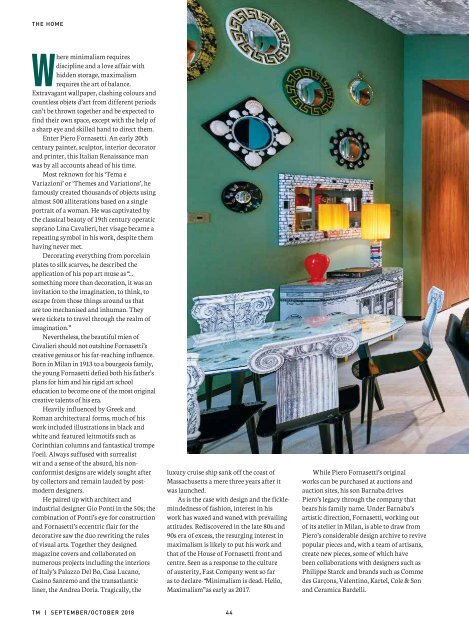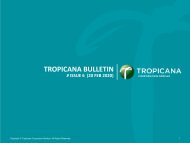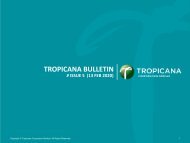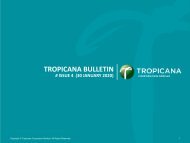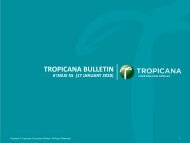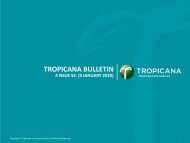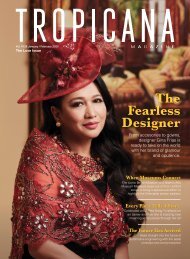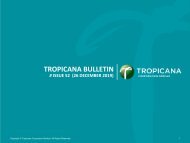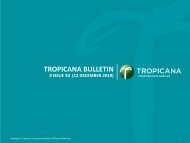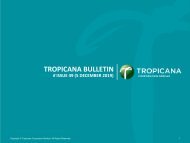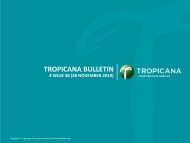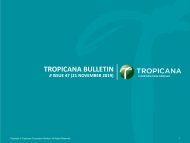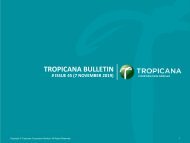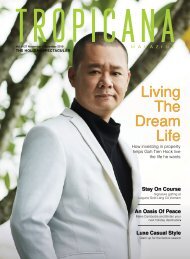Tropicana Magazine Sep-Oct 2018 #120: Art As Life
Tropicana Magazine's ART AS LIFE issue features Ai Wei Wei as the Game Changer activist of the Arts, MD of Simmons SouthEastAsia Mr Casey Teh talks about Somnology - the science of sleep; Check out our curated lists for you end of year travel plans
Tropicana Magazine's ART AS LIFE issue features Ai Wei Wei as the Game Changer activist of the Arts, MD of Simmons SouthEastAsia Mr Casey Teh talks about Somnology - the science of sleep; Check out our curated lists for you end of year travel plans
Create successful ePaper yourself
Turn your PDF publications into a flip-book with our unique Google optimized e-Paper software.
THE HOME<br />
Where minimalism requires<br />
discipline and a love affair with<br />
hidden storage, maximalism<br />
requires the art of balance.<br />
Extravagant wallpaper, clashing colours and<br />
countless objets d’art from different periods<br />
can’t be thrown together and be expected to<br />
find their own space, except with the help of<br />
a sharp eye and skilled hand to direct them.<br />
Enter Piero Fornasetti. An early 20th<br />
century painter, sculptor, interior decorator<br />
and printer, this Italian Renaissance man<br />
was by all accounts ahead of his time.<br />
Most reknown for his ‘Tema e<br />
Variazioni’ or ‘Themes and Variations’, he<br />
famously created thousands of objects using<br />
almost 500 alliterations based on a single<br />
portrait of a woman. He was captivated by<br />
the classical beauty of 19th century operatic<br />
soprano Lina Cavalieri, her visage became a<br />
repeating symbol in his work, despite them<br />
having never met.<br />
Decorating everything from porcelain<br />
plates to silk scarves, he described the<br />
application of his pop art muse as “…<br />
something more than decoration, it was an<br />
invitation to the imagination, to think, to<br />
escape from those things around us that<br />
are too mechanised and inhuman. They<br />
were tickets to travel through the realm of<br />
imagination.”<br />
Nevertheless, the beautiful mien of<br />
Cavalieri should not outshine Fornasetti’s<br />
creative genius or his far-reaching influence.<br />
Born in Milan in 1913 to a bourgeois family,<br />
the young Fornasetti defied both his father’s<br />
plans for him and his rigid art school<br />
education to become one of the most original<br />
creative talents of his era.<br />
Heavily influenced by Greek and<br />
Roman architectural forms, much of his<br />
work included illustrations in black and<br />
white and featured leitmotifs such as<br />
Corinthian columns and fantastical trompe<br />
l’oeil. Always suffused with surrealist<br />
wit and a sense of the absurd, his nonconformist<br />
designs are widely sought after<br />
by collectors and remain lauded by postmodern<br />
designers.<br />
He paired up with architect and<br />
industrial designer Gio Ponti in the 50s; the<br />
combination of Ponti’s eye for construction<br />
and Fornasetti’s eccentric flair for the<br />
decorative saw the duo rewriting the rules<br />
of visual arts. Together they designed<br />
magazine covers and collaborated on<br />
numerous projects including the interiors<br />
of Italy’s Palazzo Del Bo, Casa Lucano,<br />
Casino Sanremo and the transatlantic<br />
liner, the Andrea Doria. Tragically, the<br />
luxury cruise ship sank off the coast of<br />
Massachusetts a mere three years after it<br />
was launched.<br />
<strong>As</strong> is the case with design and the ficklemindedness<br />
of fashion, interest in his<br />
work has waxed and waned with prevailing<br />
attitudes. Rediscovered in the late 80s and<br />
90s era of excess, the resurging interest in<br />
maximalism is likely to put his work and<br />
that of the House of Fornasetti front and<br />
centre. Seen as a response to the culture<br />
of austerity, Fast Company went so far<br />
as to declare: “Minimalism is dead. Hello,<br />
Maximalism” as early as 2017.<br />
While Piero Fornasetti’s original<br />
works can be purchased at auctions and<br />
auction sites, his son Barnaba drives<br />
Piero’s legacy through the company that<br />
bears his family name. Under Barnaba’s<br />
artistic direction, Fornasetti, working out<br />
of its atelier in Milan, is able to draw from<br />
Piero’s considerable design archive to revive<br />
popular pieces and, with a team of artisans,<br />
create new pieces, some of which have<br />
been collaborations with designers such as<br />
Philippe Starck and brands such as Comme<br />
des Garçons, Valentino, Kartel, Cole & Son<br />
and Ceramica Bardelli.<br />
TM | SEPTEMBER/OCTOBER <strong>2018</strong><br />
44


